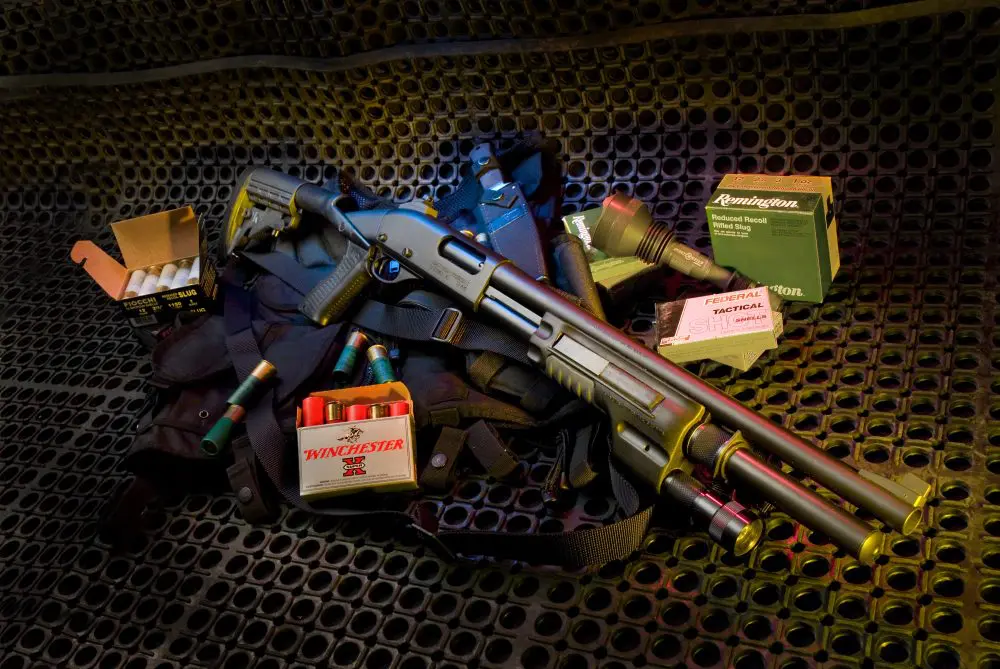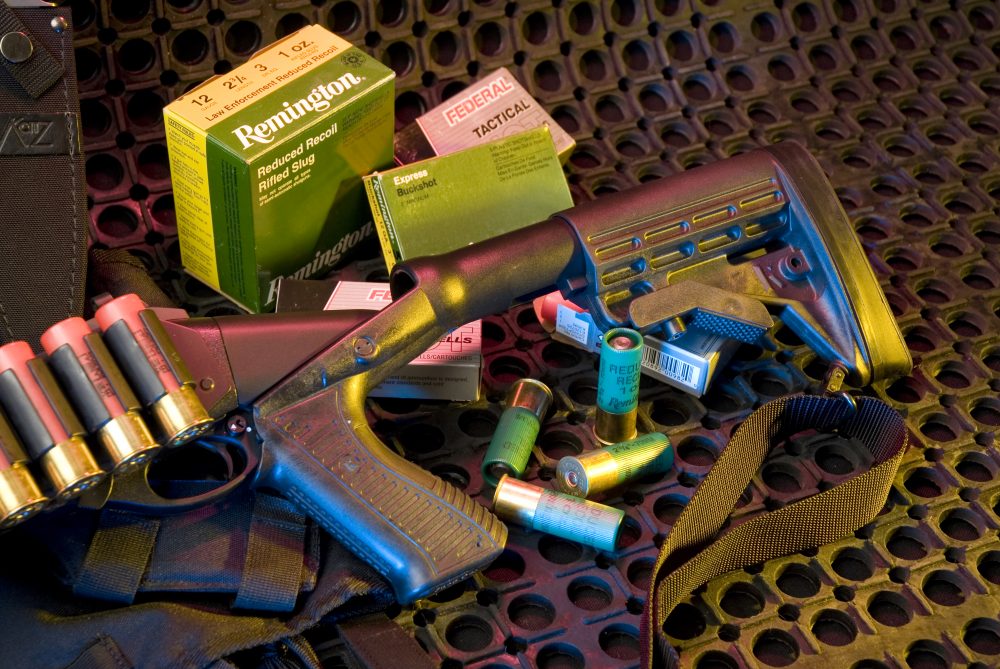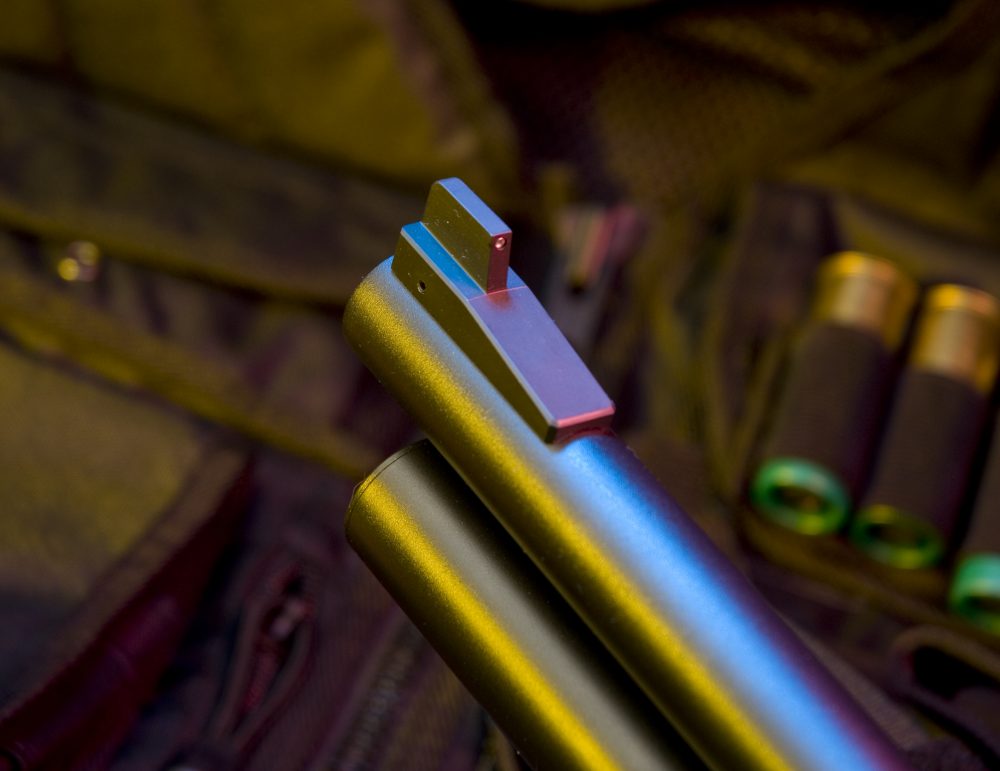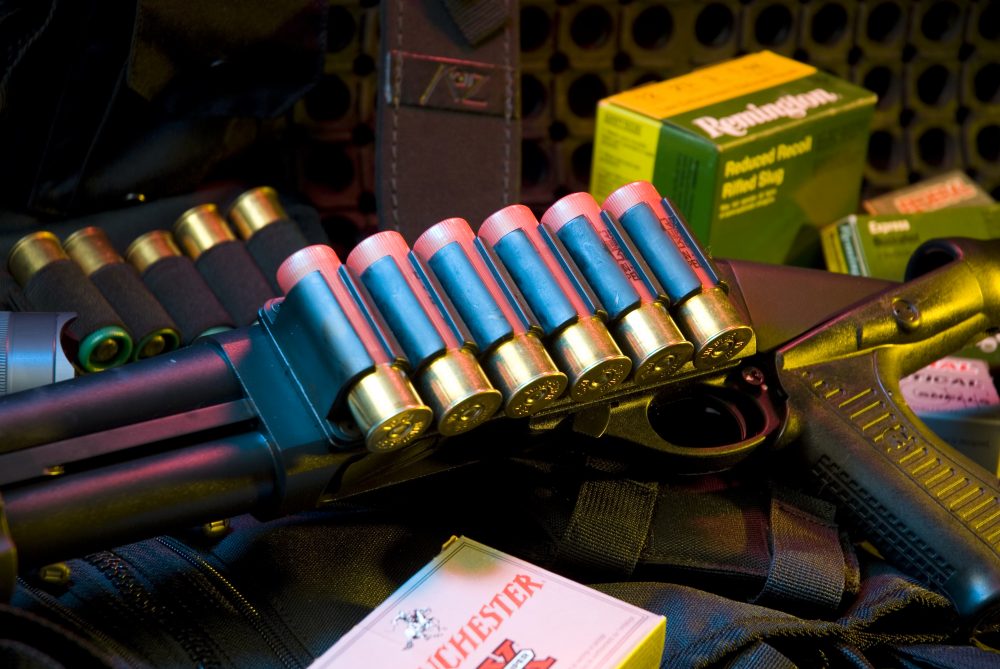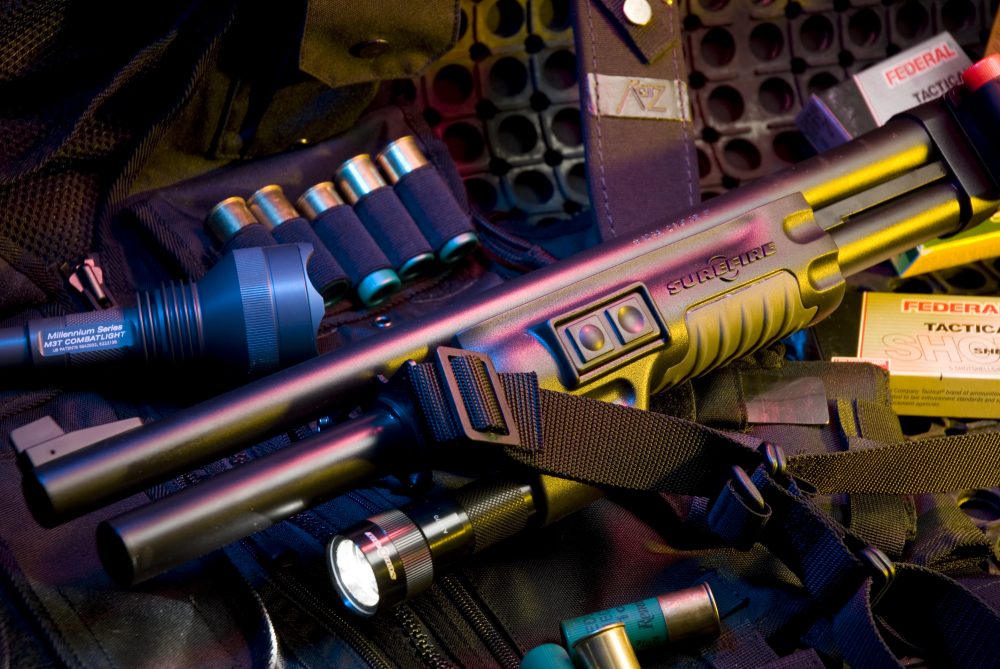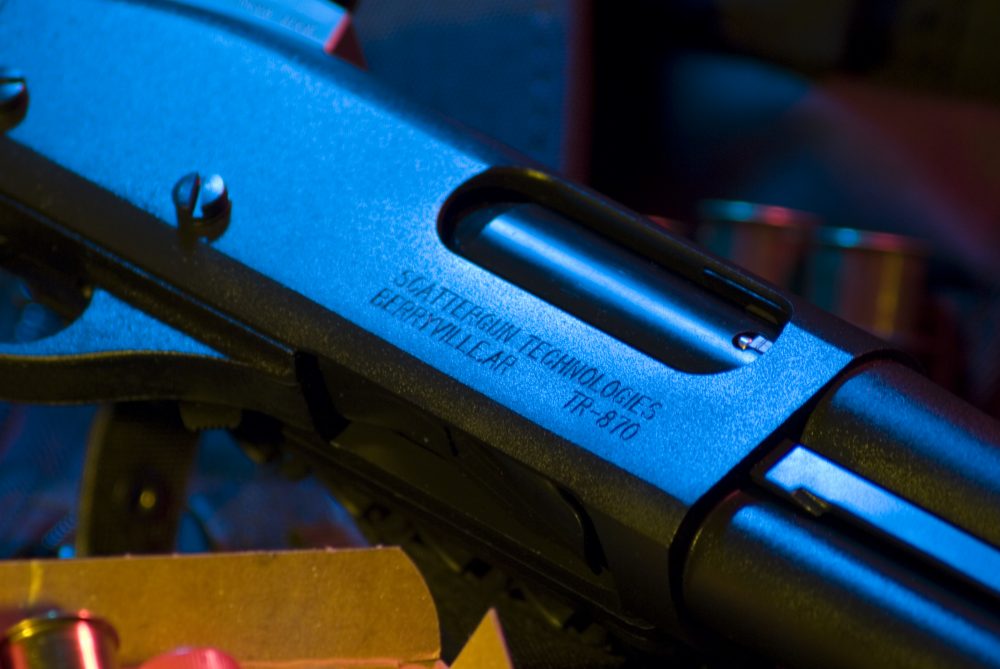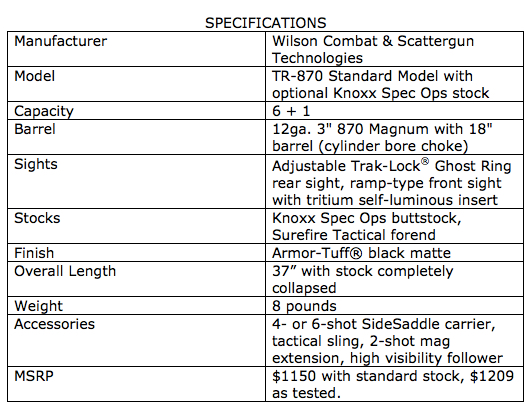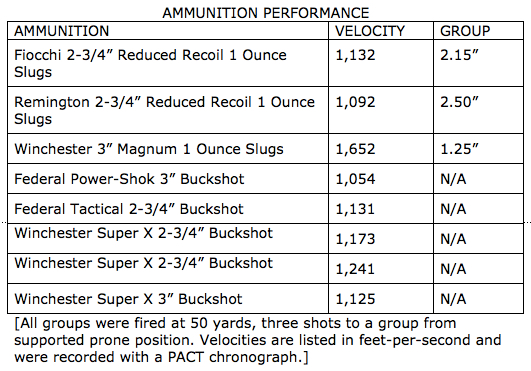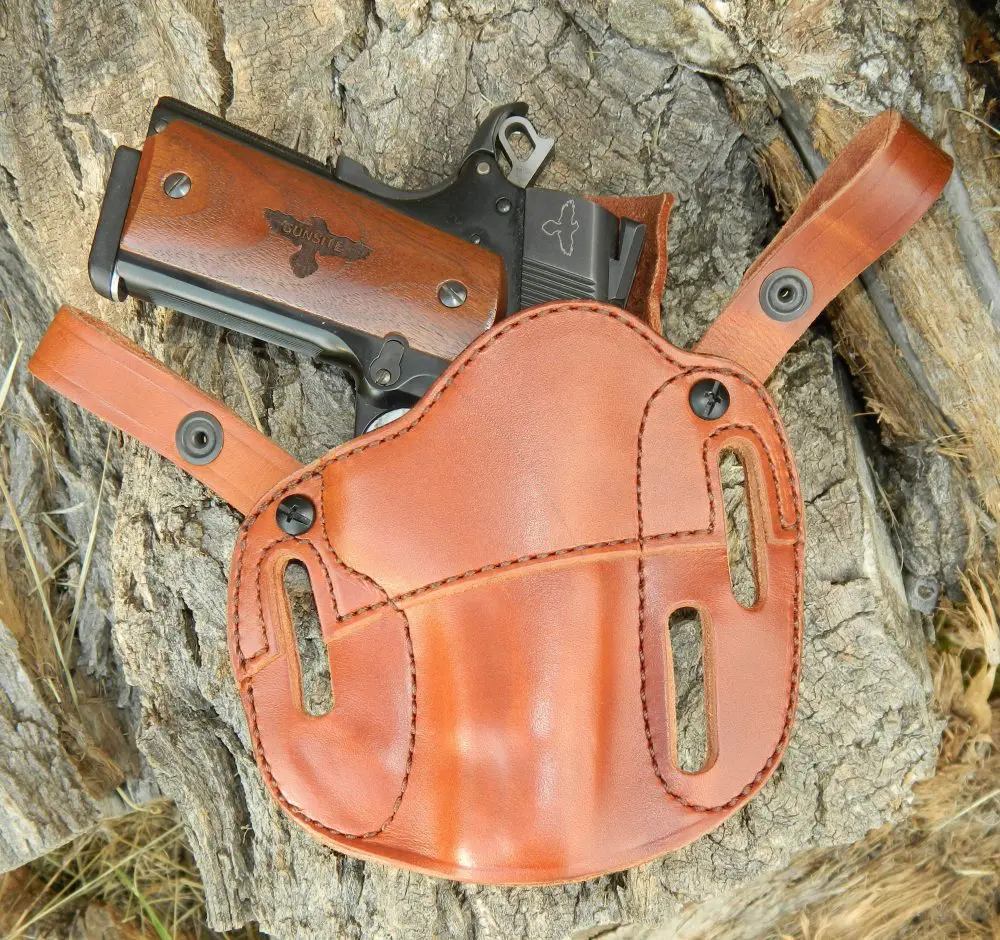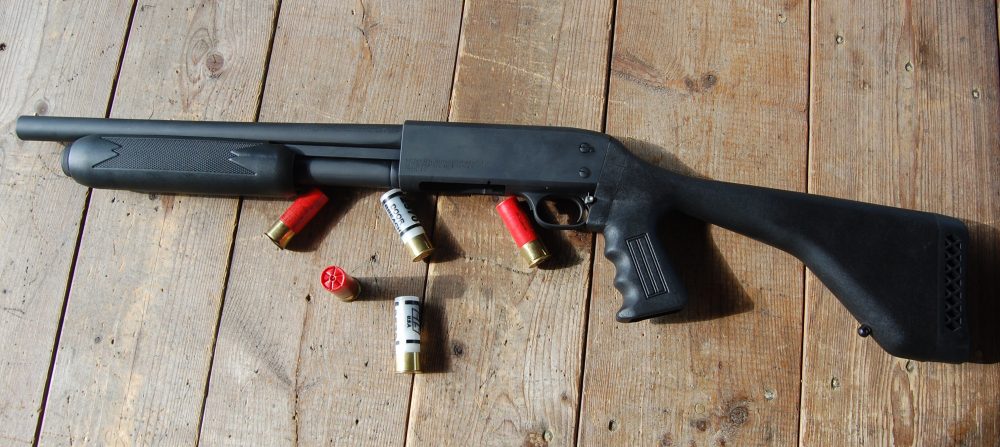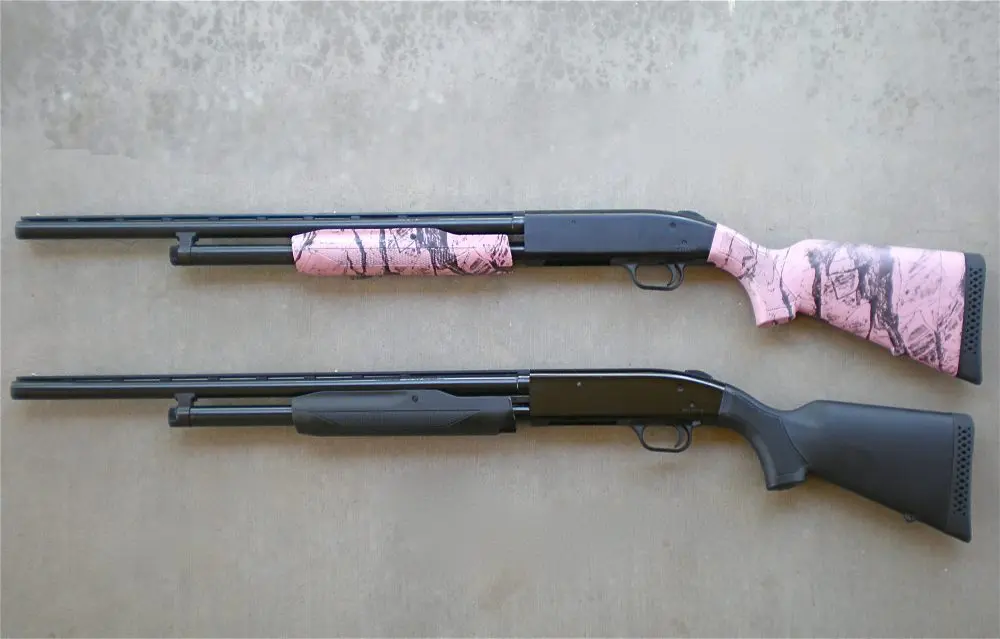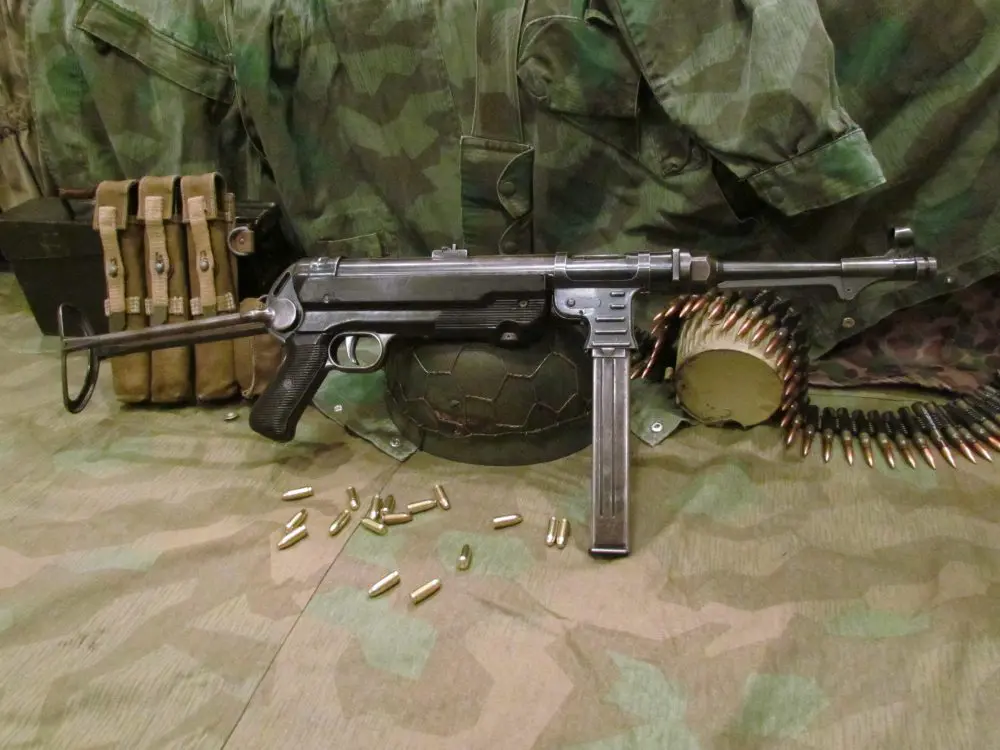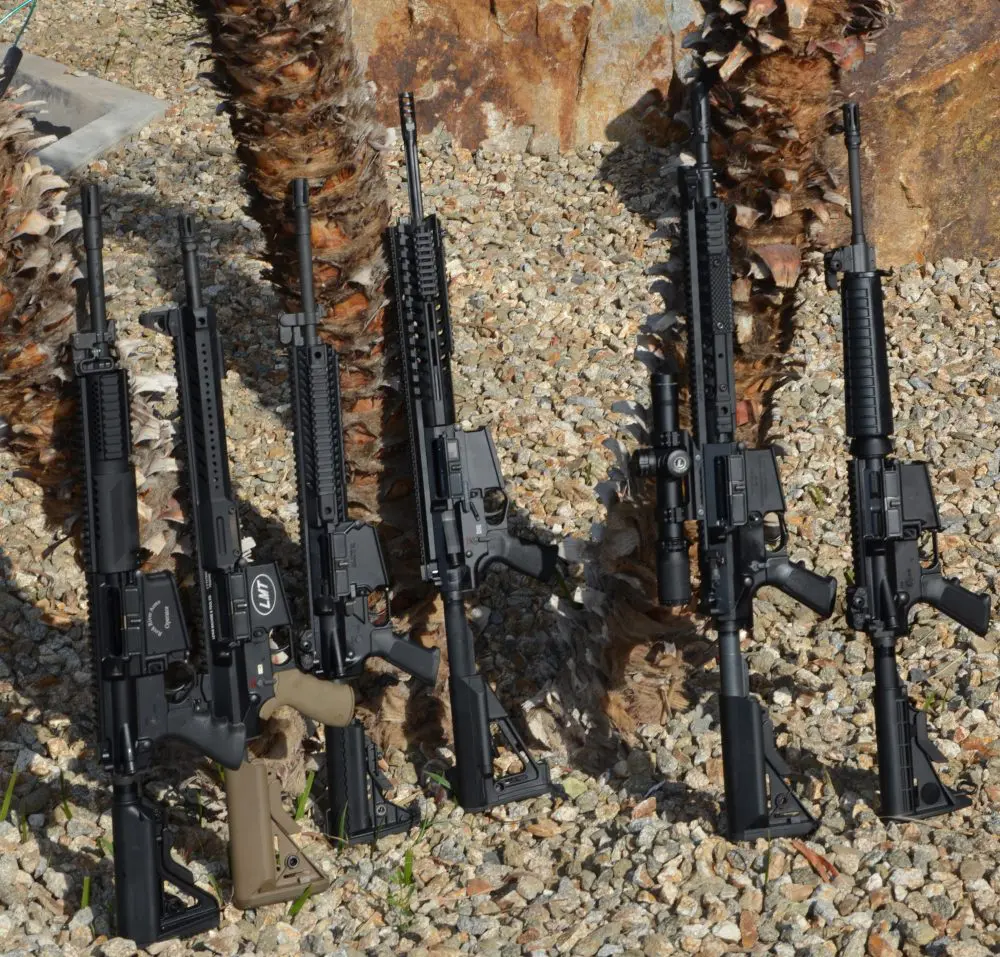Knoxx’s Spec Ops stock features two recoil-dampening mechanisms.
Without question, the Remington 870 shotgun has ridden in more police cruisers than any other scattergun in history. Its rugged design and legendary reliability make it a popular choice for departments and agencies. But even a good thing can be improved upon.
A simple formula for success in the firearms market is to take a popular design, improve upon it and sell it for a fair price. This formula is no secret to Bill Wilson, founder of Wilson Combat and owner of Scattergun Technologies. The end result of this equation is the Tactical Response®, TR-870 12-gauge shotgun.
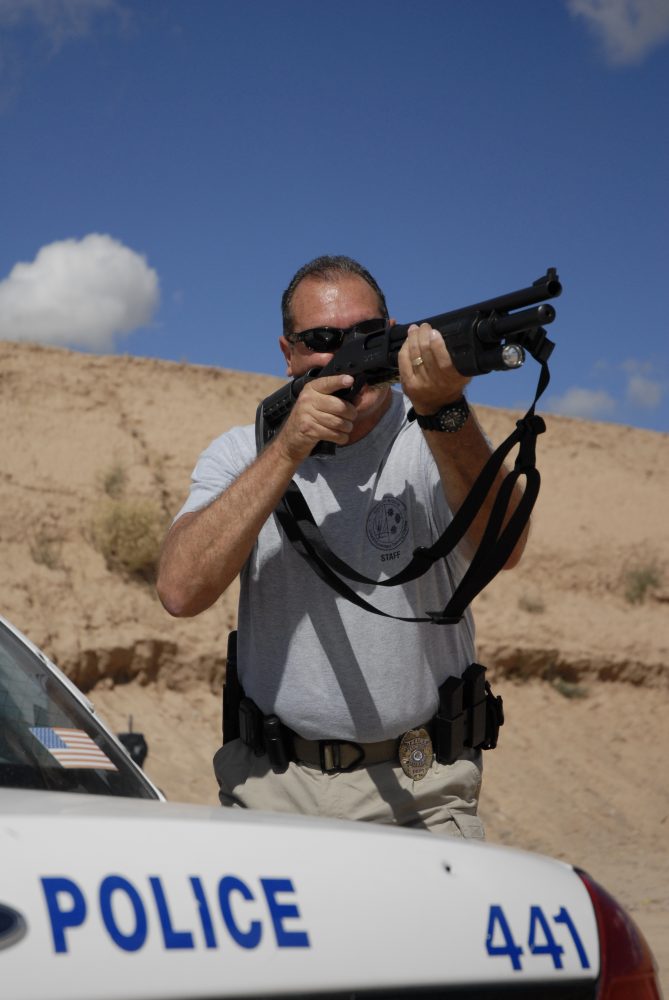
Table of Contents
MAKING A GOOD THING BETTER
Wilson uses a brand-new Remington 870 three-inch Magnum pump-action shotgun as the foundation for his custom tactical shotgun. Wilson’s gunsmiths strip the new guns and check the parts for fit and tune as needed. Trigger groups are taken apart and rebuilt with stronger springs. The magazine tube spring is also replaced with a heavy-duty part. While they’re at it, the follower is replaced with a non-binding, high-visibility follower made from a tough plastic that is unlikely to break or chip.
A two-round extension tube of their own manufacture (Scattergun Technologies) is used on the Standard Model TR-870. Unlike other manufacturers who make an extension tube so thin that a bracket is needed to hold it securely to the barrel, Scattergun’s extension tube is stout and rigid enough that no bracket is needed. In fact, grasping the magazine extension and the barrel between my thumb and forefinger and squeezing hard revealed almost no flex. While this might seem like a minor point, a gun outfitted with an extension mag tube and bracket requires a screwdriver to disassemble the gun if there is a problem in the field.
To give the shotgun the ability to place slugs with precision, Wilson outfits his Standard Model with an adjustable Trak-Lock® ghost ring rear sight. It’s a design that I like so much that I had one fitted to my Remington 1100 that I use for three-gun competition. It features a large ghost ring aperture rear sight that is adjustable for windage and elevation. Once the sight has been adjusted, the hex head screw is tightened and sight retains zero until the shooter needs to make an adjustment. While Wilson/Scattergun could easily cast this part, they chose to machine it from billet to make it as strong as possible. If the gun were to be dropped on its rear sight, I am certain that it would not shear or collapse at the aperture. Like the rest of the gun, it is rugged and effective—I like it a lot.
For low-light sighting, Standard Model uses ramp front sight with tritium insert.
The front sight is of ramp design and has a tritium insert for low-light sighting. Wilson’s gunsmiths fit this sight and its base over the Remington bead and base, epoxy it and then pin it in place. The Tactical Response shotgun uses an 18-inch Remington barrel with a three-inch chamber. The barrel has a cylinder bore choke.
Once the base gun has been stripped, inspected and tuned, its parts are thoroughly blasted with a fine grit media. They are then washed and the carbon steel parts parkerized. Scattergun technicians then apply the Armor-Tuff® finish. Parts are sprayed and then thermally cured. Once treated, the Armor-Tuff® applied over the parkerized texture provides the user with a tough finish that is corrosion resistant and provides a barrier to acids, oils, solvents, bore cleaners, etc. My test sample wears a handsome, matte black finish that is consistent over the entire surface of the gun. One of the benefits of the Armor-Tuff® finish is that it is self-lubricious. Pumping the action of the TR-870 is incredibly smooth.
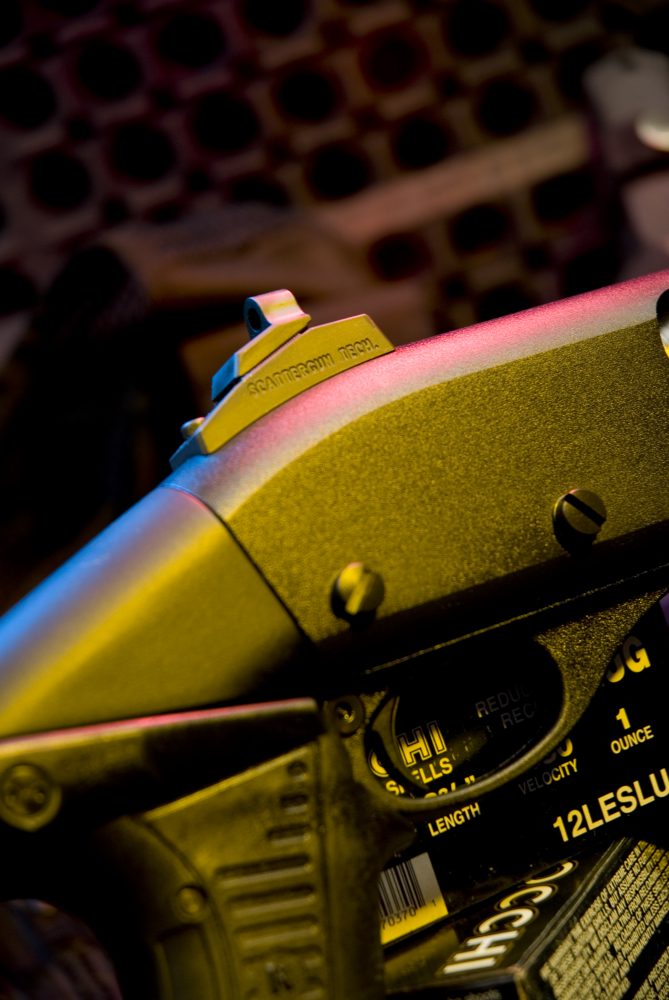
ACCESSORIES
Because of its popularity, the Remington 870 shotgun has many aftermarket accessories available for it. The Knoxx Spec Ops stock is an option for the Standard Model TR-870. It features two recoil compensation mechanisms to dampen the punch of heavy loads. When the gun is fired, the receiver recoils rearward and activates a roller and cam lever, attached to a strong spring, located inside the pistol grip. The spring helps absorb the recoil energy and slows the receiver’s movement until it reaches the end of its inch and a half travel, then the spring pressure pulls the receiver back into its original position.
There’s another heavy-duty spring in the area that we would normally call the buffer tube on an AR-15/M16 stock. This spring acts like a shock absorber and cushions the shock that the buttplate transfers to the shoulder. It should be noted that this M4-looking stock is sized specifically for the shotgun and the parts are not interchangeable with those of an M4.
But it does work like an M4 stock in that it can collapse and expand. The Spec Ops is instantly adjustable from a minimum of 11.25 inches to a maximum of 15.25 inches by pressing a lever and pulling or pushing the stock to the desired length. The rubber butt pad can be removed with a Phillips screwdriver, and the butt plate is textured.
The TR-870 Standard Model also uses the SureFire Tactical Forend to give the gun night-fighting capability. There’s a pressure-sensitive pad on the right side of the forearm for temporary illumination and an On/Off rocker switch on the other side for sustained light. It uses two, 3-volt lithium batteries, capable of producing a blinding 65 lumens of light for up to one hour. I like it because its controls fall naturally within reach of my fingers for easy activation. It’s built tough and rugged enough to stand up to the punishment of heavy 12-gauge loads and the rigors of police use.
My TR-870 sample has a six-shot SideSaddle shell carrier, but the gun is also available with a four-shot SideSaddle. Other accessories include a Scattergun Technologies magazine tube sling mount and a tactical sling. I can’t think of another thing that someone would need to add to use this as a working police or self-defense shotgun.
Knoxx’s Spec Ops stock features two recoil-dampening mechanisms.
SHOOTING IMPRESSIONS
I set an IPSC target at 50 yards and laid down in the back of my Suburban and used a portable rifle rest for support. It was easy to obtain an uncluttered sight picture thanks to the Scattergun Technologies Trak-Lock rear sight and ramp front sight. My T&E sample gun has a fabulous trigger that breaks at a crisp four pounds and actually feels more like a rifle trigger than that of a shotgun.
I started with Remington’s Reduced Recoil 1-ounce slugs and was impressed with just how little recoil there was. I was actually able to keep the front sight on the target as the gun recoiled. I rested the Surefire forend on my rifle rest and with each shot the gun extracted the round and came to within about half an inch of ejecting the empty shell. That’s how smooth the gun cycles! I used my support hand to hold the butt of the Knoxx stock against my shoulder. At 50 yards, my average three-shot group measured 2.5 inches.
Next, I tried Fiocchi’s 1-ounce reduced recoil slugs and managed to average 2.15 inches for three shots. Again, these reduced recoil loads proved very comfortable to shoot.
Standard Model is available with either four- or six-round sidesaddle shell carrier.
The most accurate slugs that I tried, though, averaged just 1.25 inches! I couldn’t get over how accurate this load was. However, shooting the 3-inch Magnum Winchester 1-ounce slug was like hitting myself in the face with a hammer. After each shot, I literally had to wipe tears from my eyes to get a decent sight picture. While the Knoxx stock protected my shoulder very efficiently, it did nothing to protect my cheek. To get a good sight picture, I needed to lift my head about 3/8-inch off the stock, and with each shot I’d get a good wallop. I fired three, 3-shot groups and then three shots over the chronograph to get an average velocity. That’s it. That was all that I wanted to fire of the Winchester Magnum 3-inch, 1-ounce slugs.
Surefire Tactical Forend is part of Tactical Response Standard Model package.
The Winchester 3-inch Magnum 00 Buckshot loads are almost as painful to shoot. Even from a standing position, when I chronographed the loads I was still getting a good smack-around with each trigger slap. Fortunately, I had also brought along Federal Tactical 2-3/4-inch 00 Buckshot loads. Fired through the Standard Model equipped with the Knoxx stock, these rounds felt only slightly warmer than promotional birdshot loads.Scattergun Technologies chokes the Standard Model with cylinder bore and that explains the excellent accuracy with slugs. To give an idea of how this open choke works with buckshot, I used the Federal Tactical Buckshot loads and fired a round at 15, 25 and 50 yards. At 15 yards the pattern was a ragged hole that measured just 1.5 inches center-to-center. At 25 yards the nine pellets produced a 7-inch cluster and at 50 yards the pattern opened up to a 20-inch cone. This shotgun used properly—with a thorough understanding of its range limitations—will do everything that could be appropriately asked of it.
I wanted to put this gun in the hands of someone who has a lot of experience with Remington shotguns to see how they like the improvements and modifications that have been made by Scattergun Technologies. Ed Chavez is a 21-year veteran of the Tucson Police Department. The former Recon Marine works as a pistol, patrol-rifle and shotgun instructor at the Southern Arizona Law Enforcement Training Center. After a tour of their beautiful state-of-the-art training facility, which includes an Action Target Shoot House, we adjourned to an empty shooting bay to see just what he could do with the TR-870.
TR-870 is heavily blasted with a fine media, parkerized and then Armor-Tuff®’d for a matte, corrosion-resistant finish.
I was curious to see just how fast Chavez could work the action of this custom Remington shotgun, so I brought along a couple boxes of Winchester 2-3/4” birdshot loads. I used a PACT electronic timer to measure the time between shots. The shortest split, or time between shots, was an amazing 24/100ths of a second. To put things in perspective, this split is about what I can do with a .45 1911 firing double taps–on a good day. The fact that Chavez was able to do this with a manually operated 12-gauge shotgun thoroughly impresses me. His splits were consistently under 30/100ths of a second. Like me, Chavez was extremely impressed with the TR-870’s slick action.
FINAL THOUGHTS
The suggested retail price of the Scattergun Technologies TR-870 Standard Model, with the Knoxx Spec Ops stock, is $1,209. If you think that sounds high, try adding up the cost of a new shotgun, accessories like the Knoxx stock, Surefire Tactical Forend, Trak-Lock sights, magazine extension and SideSaddle. Don’t forget to add in the cost of the Armor-Tuff finish. I think that you’ll find it would cost several hundred dollars more to replicate the TR-870.
If you already own a Remington 870—whether it’s an old riot gun or a well-worn Wingmaster—Scattergun Technologies can rebuild the gun as the TR-870 Standard Model for $875.
SOURCE:
Wilson Combat & Scattergun Technologies
Dept. S.W.A.T.
2234 CR 719
Berryville, AR 72616
(800) 955-4856
www.wilsoncombat.com
